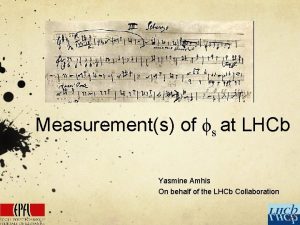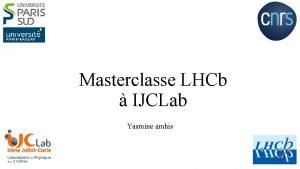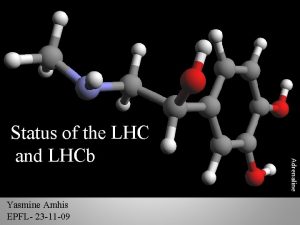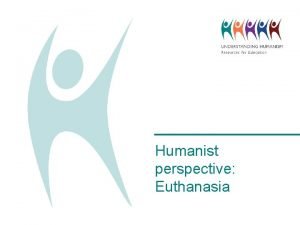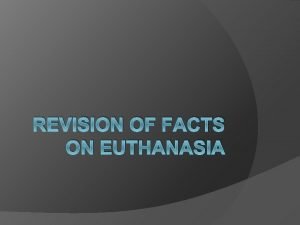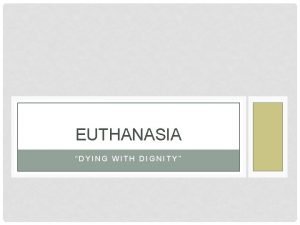EUTHANASIA JOSH ADJEI ANSH SHARMA YASMINE HUANCA ASHLEN








- Slides: 8

EUTHANASIA JOSH ADJEI, ANSH SHARMA, YASMINE HUANCA, ASHLEN CHEVALIER

Background Information • Physician assisted suicide (or euthanasia)- painless killing of a patient who is suffering from terminal, painful disease or is in a coma • Types of Euthanasia: • Voluntary- when euthanasia is conducted with consent • Non-voluntary- when euthanasia is conducted on a person who is unable to consent due to their current health condition, and the decision is made by a family member • Involuntary- when euthanasia is performed on a person who would be able to provide informed consent, but does not

Claim • Voluntary and non-voluntary euthanasia should be legal everywhere in the United States because: • It is a violation of human rights to force one to live with a painful and incurable disease • It is the best thing to do morally • It follows the Hippocratic oath • Voluntary euthanasia is now legal in only Oregon and Washington

Violation of human rights • Our constitution states that we are all entitled to life, liberty, and the pursuit of happiness. • Generally, people view death only as the end to one’s life, but in many cases, it is also the end to one’s suffering. • Supporters of the “aid in dying” movement believe that it is closely related to the American values of individual liberty and freedom of choice. Barbara Coombs Lee, the president of an organization called Compassion & Choices states, “We don’t promote just one choice. We think people deserve an entire spectrum of choices”. • If someone’s pursuit of happiness involves a quick and painless death, then they have the right to it. The right to life also includes the right to die, and not to simply just exist.

Morality • It is not immoral to put someone out of their misery • Putting someone out their misery is rational and compassionate • While requiring someone to suffer against their wishes is immoral • Euthanizing someone ultimately decreases the persons suffering

Hippocratic Oath • Euthanasia is not against the Hippocratic Oath • The oath states that doctors should “ do no harm to the patient”. However some may argue that forcing a person to live is doing harm to them. • The oath also says to “help the sick”, so ending a terminally ill patients’ life by thier request is helping the patient.

Refutation • Some believe that if voluntary euthanasia is legal, then soon involuntary euthanasia will be legal (slippery slope) • However: • The slippery slope argument is a scare tactic • There will be safeguards preventing involuntary euthanasia

BIBLIOGRAPHY • Nordqvist, C. (2018, December 17). Euthanasia and assisted suicide: What are they and what do they mean? Retrieved from Euthanasia • Benatar, D. (2019). A legal right to die: responding to slippery slope and abuse arguments. [online] Pub. Med Central (PMC). legal right [Accessed 6 Mar. 2019]. • BBC - Ethics - Euthanasia: Anti-euthanasia arguments. (2019). Retrieved from Against • About ALS. (n. d. ). Retrieved from http: //www. alsa. org/about-als/

